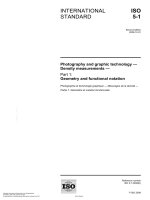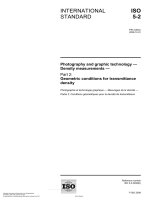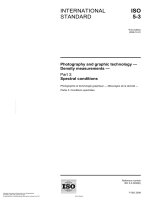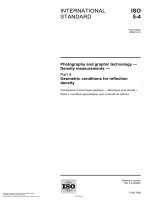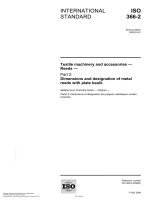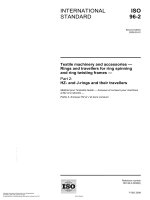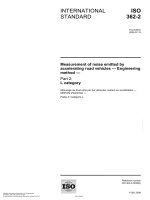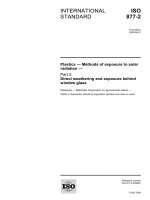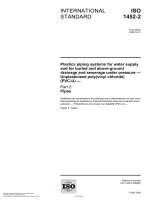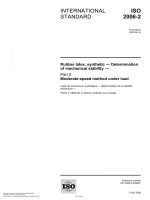Tiêu chuẩn iso 00005 2 2009
Bạn đang xem bản rút gọn của tài liệu. Xem và tải ngay bản đầy đủ của tài liệu tại đây (296.56 KB, 20 trang )
INTERNATIONAL
STANDARD
ISO
5-2
Fifth edition
2009-12-01
Photography and graphic technology —
Density measurements —
Part 2:
Geometric conditions for transmittance
density
Photographie et technologie graphique — Mesurages de la densité —
Partie 2: Conditions géométriques pour la densité de transmittance
Reference number
ISO 5-2:2009(E)
--`,,```,,,,````-`-`,,`,,`,`,,`---
Copyright International Organization for Standardization
Provided by IHS under license with ISO
No reproduction or networking permitted without license from IHS
© ISO 2009
Not for Resale
ISO 5-2:2009(E)
PDF disclaimer
This PDF file may contain embedded typefaces. In accordance with Adobe's licensing policy, this file may be printed or viewed but
shall not be edited unless the typefaces which are embedded are licensed to and installed on the computer performing the editing. In
downloading this file, parties accept therein the responsibility of not infringing Adobe's licensing policy. The ISO Central Secretariat
accepts no liability in this area.
Adobe is a trademark of Adobe Systems Incorporated.
Details of the software products used to create this PDF file can be found in the General Info relative to the file; the PDF-creation
parameters were optimized for printing. Every care has been taken to ensure that the file is suitable for use by ISO member bodies. In
the unlikely event that a problem relating to it is found, please inform the Central Secretariat at the address given below.
COPYRIGHT PROTECTED DOCUMENT
© ISO 2009
All rights reserved. Unless otherwise specified, no part of this publication may be reproduced or utilized in any form or by any means,
electronic or mechanical, including photocopying and microfilm, without permission in writing from either ISO at the address below or
ISO's member body in the country of the requester.
--`,,```,,,,````-`-`,,`,,`,`,,`---
ISO copyright office
Case postale 56 • CH-1211 Geneva 20
Tel. + 41 22 749 01 11
Fax + 41 22 749 09 47
Web www.iso.org
Published in Switzerland
ii
Copyright International Organization for Standardization
Provided by IHS under license with ISO
No reproduction or networking permitted without license from IHS
© ISO 2009 – All rights reserved
Not for Resale
ISO 5-2:2009(E)
Contents
Page
Foreword ............................................................................................................................................................iv
Introduction.........................................................................................................................................................v
Scope ......................................................................................................................................................1
2
Normative references............................................................................................................................1
3
Terms and definitions ...........................................................................................................................1
4
Coordinate system, terminology and symbols ..................................................................................2
5
Distinction between ideal and realized parameters...........................................................................2
6
6.1
6.2
6.3
6.4
6.5
Requirements for ISO 5 standard diffuse transmittance density .....................................................2
Geometric modes ..................................................................................................................................2
Sampling aperture .................................................................................................................................3
Diffuse distribution................................................................................................................................5
Directional distribution .........................................................................................................................5
Designation ............................................................................................................................................6
7
7.1
7.2
7.3
7.4
Requirements for ISO 5 standard projection transmittance density ...............................................6
Geometric modes ..................................................................................................................................6
Sampling aperture .................................................................................................................................6
Directional distributions .......................................................................................................................7
Designation ............................................................................................................................................7
8
Conformance testing.............................................................................................................................7
--`,,```,,,,````-`-`,,`,,`,`,,`---
1
Annex A (normative) Diffusion coefficient .......................................................................................................8
Annex B (normative) Determining conformance with tolerances................................................................11
Annex C (informative) Unmatched influx and efflux angles .........................................................................12
Bibliography......................................................................................................................................................13
iii
© ISO 2009 – All rights reserved
Copyright International Organization for Standardization
Provided by IHS under license with ISO
No reproduction or networking permitted without license from IHS
Not for Resale
ISO 5-2:2009(E)
Foreword
ISO (the International Organization for Standardization) is a worldwide federation of national standards bodies
(ISO member bodies). The work of preparing International Standards is normally carried out through
ISO technical committees. Each member body interested in a subject for which a technical committee has
been established has the right to be represented on that committee. International organizations, governmental
and non-governmental, in liaison with ISO, also take part in the work. ISO collaborates closely with the
International Electrotechnical Commission (IEC) on all matters of electrotechnical standardization.
International Standards are drafted in accordance with the rules given in the ISO/IEC Directives, Part 2.
The main task of technical committees is to prepare International Standards. Draft International Standards
adopted by the technical committees are circulated to the member bodies for voting. Publication as an
International Standard requires approval by at least 75 % of the member bodies casting a vote.
Attention is drawn to the possibility that some of the elements of this document may be the subject of patent
rights. ISO shall not be held responsible for identifying any or all such patent rights.
ISO 5-2 was prepared by ISO/TC 42, Photography, and ISO/TC 130 Graphic technology, in a Joint Working
Group.
This fifth edition cancels and replaces the fourth edition (ISO 5-2:2001), which has been technically revised.
This technical revision introduces the concept of ideal and practical conditions. In the course of this technical
revision, all parts of ISO 5 have been reviewed together, and the terminology, nomenclature and technical
requirements have been made consistent across all parts.
ISO 5 consists of the following parts, under the general title Photography and graphic technology — Density
measurements:
⎯
Part 1: Geometry and functional notation
⎯
Part 2: Geometric conditions for transmittance density
⎯
Part 3: Spectral conditions
⎯
Part 4: Geometric conditions for reflection density
--`,,```,,,,````-`-`,,`,,`,`,,`---
iv
Copyright International Organization for Standardization
Provided by IHS under license with ISO
No reproduction or networking permitted without license from IHS
© ISO 2009 – All rights reserved
Not for Resale
ISO 5-2:2009(E)
Introduction
This part of ISO 5 specifies the geometric conditions for transmittance densitometry, primarily (but not
exclusively) as practised in black-and-white and colour photography and graphic technology. This part of
ISO 5 is intended to specify geometrical conditions for the measurement of optical densities that are close to
those used in practice. Diffuse transmittance densities are, among other things, relevant for contact printing
and rating films on viewing boxes. Viewing films on light boxes is one of the most important applications where
diffuse transmittance densities are relevant. Therefore, the specified conditions for the measurement of diffuse
transmittance densities consider the properties of viewing boxes concerning diffusivity and the spectral
reflectance factor. Another important application is the measurement of the diffuse transmittance density and
hence the opaque area percentage of lithography-type black-and-white films for graphic technology. This part
of ISO 5 also describes the geometric conditions for two types of projection density. The spectral conditions
are specified in ISO 5-3.
The primary change between the first edition of this part of ISO 5 (published in 1974) and the second edition
(published in 1985) was the replacement of the integrating sphere method with a diffuser (typically “opal
glass”) as the basis for specifying ISO 5 standard diffuse transmittance density. Although any means of
diffusion that meets the specifications of this part of ISO 5 can be used, the method is often denoted simply by
the words “opal glass” in order to differentiate it from the integrating sphere method. Slightly smaller density
values are generally obtained compared to those based on the integrating sphere method because of interreflections between the opal glass and the specimen. The effect is dependent on the reflectance
characteristics of the opal glass and the surface of the specimen facing the diffuser.
Diffuse transmittance density is a measure of the modulation of light by a film that is diffusely irradiated on one
side and viewed from the other, as when a film is viewed on a diffuse transparency illuminator. The geometric
conditions of projection with diffuse illumination are nearly equivalent to the conditions of viewing a film on a
diffuse illuminator, the projection lens taking the place of the eye. When film is on a diffuse illuminator or in
contact with a print material, light is inter-reflected between the film and the nearby surface. This interreflection affects the density and is best taken into account in a measuring instrument by the use of an opalglass diffuser or integrator, rather than an integrating sphere. Apart from this fundamental reason for using
densitometers employing opal-glass diffusers, such instruments are preferred because they are more durable
and more convenient to manufacture and use.
--`,,```,,,,````-`-`,,`,,`,`,,`---
Projection density is a measure of the modulation of light by a film that is regularly illuminated on one side and
is projected by way of a regular collection system. Equipment employing optical condensers is used to view
microfilm, motion pictures, and slides, and to make projection prints. The conditions defined in this part of
ISO 5 for projection density simulate the geometric conditions affecting the transmitting characteristics of a
small area on a negative or transparency at the centre of the frame of a typical projection system employing
condensers. The area under consideration can be defined by a small opening, known as the “sampling
aperture”, in an otherwise opaque sheet in the frame.
The measured density depends on the half-angle of the cone of incident rays and the half-angle subtended by
the projection lens at the sampling aperture. These half-angles can be indicated either in degrees or by
ƒ-numbers. Since the ƒ-number is usually marked on projection lenses, the two types of ISO 5 standard
projection density specified in this part of ISO 5 are identified by ƒ-numbers, namely ƒ/4,5 and ƒ/1,6. The ƒ/4,5
type is frequently used, since it is representative of microfilm readers. The ƒ/1,6 type is considered
representative of motion-picture projectors.
Significant changes from the fourth edition of this part of ISO 5 are explained below.
a)
The terminology “transmission density” has been replaced by the term “transmittance density” for both
diffuse and projection densities. Both densities require measurements relative to the incident flux (influx),
and therefore the regular or diffuse transmittance of the specimen is measured. As explained in ISO 5-1,
the correct density term corresponding to regular transmittance is “transmittance density”.
v
© ISO 2009 – All rights reserved
Copyright International Organization for Standardization
Provided by IHS under license with ISO
No reproduction or networking permitted without license from IHS
Not for Resale
ISO 5-2:2009(E)
b)
vi
A distinction is made between ideal and realized parameters for transmittance density. The definition of
ISO 5 standard transmittance density is based upon ideal values specified for each parameter. However,
actual instruments require reasonable tolerances for physical parameters, which are specified by the
realizable parameters.
© ISO 2009 – All rights reserved
--`,,```,,,,````-`-`,,`,,`,`,,`---
Copyright International Organization for Standardization
Provided by IHS under license with ISO
No reproduction or networking permitted without license from IHS
Not for Resale
INTERNATIONAL STANDARD
ISO 5-2:2009(E)
Photography and graphic technology — Density
measurements —
Part 2:
Geometric conditions for transmittance density
1
Scope
This part of ISO 5 specifies the geometric conditions for measuring ISO 5 standard diffuse and ƒ/4,5 and ƒ/1,6
projection transmittance densities.
ISO 5 standard diffuse density is primarily applicable to measurements of photographic images to be viewed
on a transparency illuminator, or viewing box, to be contact printed, or to be projected with a system
employing diffuse illumination.
ISO 5 standard projection density is primarily applicable to measurements of photographic images to be
projected with systems employing optical condensers.
Although primarily intended for the measurement of photographic images, the densitometric methods
specified in this part of ISO 5 are often applied to optical filters and other transparent materials.
2
Normative references
The following referenced documents are indispensable for the application of this document. For dated
references, only the edition cited applies. For undated references, the latest edition of the referenced
document (including any amendments) applies.
ISO 5-1, Photography and graphic technology — Density measurements — Part 1: Geometry and functional
notation
ISO 5-3, Photography and graphic technology — Density measurements — Part 3: Spectral conditions
3
Terms and definitions
For the purposes of this document, the terms and definitions given in ISO 5-1 and the following apply.
3.1
diffusion coefficient
βdc
measure of the diffusivity of the illuminating or receiving system
See Annex A.
1
© ISO 2009 – All rights reserved
Copyright International Organization for Standardization
Provided by IHS under license with ISO
No reproduction or networking permitted without license from IHS
Not for Resale
--`,,```,,,,````-`-`,,`,,`,`,,`---
NOTE
ISO 5-2:2009(E)
3.2
transmittance
τ
ratio of the transmitted flux to the incident flux under specified geometrical and spectral conditions of
measurement
NOTE 1
In practical instruments for transmittance measurements, the incident flux is defined by the combination of all
of the components that are placed before the reference plane (influx), so the incident flux is provided by the surface of the
opal diffuser for diffuse transmittance and by the film gate for projection density.
NOTE 2
Adapted from ASTM E284.
[ISO 5-1:2009, definition 3.22]
NOTE
--`,,```,,,,````-`-`,,`,,`,`,,`---
3.3
transmittance density
Dτ
negative logarithm to the base 10 of the transmittance
The subscript is the lower case Greek letter tau.
[ISO 5-1:2009, definition 3.23]
4
Coordinate system, terminology and symbols
The coordinate system, terminology, and symbols described in ISO 5-1 are used in this part of ISO 5 as a
basis for specifying the geometric conditions for ISO 5 standard transmittance density measurements.
5
Distinction between ideal and realized parameters
The unambiguous definition of ISO 5 standard density requires that geometric, as well as spectral, parameters
be exactly specified. However, the practical design and manufacture of instruments requires that reasonable
tolerances be allowed for physical parameters. The definition of ISO 5 standard transmittance density shall be
based on the ideal value specified for each parameter. The tolerances shown for the realized parameter
values represent allowable variations of these standard parameters, which for many applications have an
effect of less than 0,01 on the density values resulting from measurements made with instruments. A method
for determining conformance of a realized parameter with the tolerances is given in Annex B.
6
6.1
Requirements for ISO 5 standard diffuse transmittance density
Geometric modes
Diffuse transmittance density measurements may be made with two equivalent measurement geometries. In
the “diffuse influx mode”, the geometry of the illuminator is diffuse and the geometry of the receiver is
directional, while in the “diffuse efflux mode”, the geometry of the illuminator is directional and the geometry of
the receiver is diffuse. These modes are defined in Figure 1. A diffuse illuminator projects radiant flux onto the
sampling aperture from all directions within the hemisphere, while a diffuse receiver collects radiant flux
transmitted by the sampling aperture in all directions within the hemisphere. The modes can be described in
terms of specified diffuse and directional distributions of illumination radiance or receiver responsivity,
depending on the mode. The cone half-angle, κ, is the angle between the angle of illumination or view and the
marginal ray. A cone half-angle of 90° indicates that the illuminator or receiver has a diffuse geometry.
Referring to the cone half-angles shown in Figure 1, the ideal angles of illumination and view and half-angles
for the diffuse influx mode are θ i = 0°, κi = 90°, and θ t = 0°, κt = 10°. For the diffuse efflux mode, the ideal
angles of view and illumination and half-angles are θ t = 0°, κt = 90°, and θ i = 0°, κi = 10°.
2
Copyright International Organization for Standardization
Provided by IHS under license with ISO
No reproduction or networking permitted without license from IHS
© ISO 2009 – All rights reserved
Not for Resale
ISO 5-2:2009(E)
The realized angles of illumination and view and half-angles for the diffuse influx mode are θ i = 0° ± 2°,
κi = 90°, and θ t = 0° ± 2° κt = 10° ± 2°. For the diffuse efflux mode, the realized angles of view and illumination
and half-angles are θ t = 0° ± 2°, κt = 90°, and θ i = 0° ± 2°, κi = 10° ± 2°.
NOTE
The 90° specification implies physical contact between the specimen and the diffuse illuminator or receiver.
For diffuse density measurement with diffuse influx: κi = 90° and κt = 10°.
For diffuse density measurement with diffuse efflux: κi = 10° and κt = 90°.
For projection density measurements, for ƒ/4,5: κi = κt = 6,4°.
For projection density measurements, for ƒ/1,6: κi = κt = 18,2°.
Key
1
2
influx geometry
efflux geometry
3
4
sampling aperture
aperture simulating the entrance pupil of projection lens
5
point O
Figure 1 — Geometry for ISO 5 standard transmittance density measurements
6.2
Sampling aperture
The extent and shape of the area on which density is measured is the sampling aperture. Physically, the
sampling aperture is realized by a diaphragm, which shall be in contact with the specimen to be measured.
Figure 2 shows the four combinations which may be applied: two for the diffuse influx mode and two for the
diffuse efflux mode. All other combinations are excluded.
--`,,```,,,,````-`-`,,`,,`,`,,`---
NOTE 1
Figure 2 shows, for combinations b) and d), that the opaque material of the diaphragm constitutes a smooth
surface with the diffusing material. This can be obtained by grinding the opal glass and filling the recess with an
appropriate opaque material. Since these combinations are rather costly, combinations a) and c) will be preferred in
practice.
© ISO 2009 – All rights reserved
Copyright International Organization for Standardization
Provided by IHS under license with ISO
No reproduction or networking permitted without license from IHS
Not for Resale
3
ISO 5-2:2009(E)
a) Diffuse influx mode 1
c) Diffuse efflux mode 1
b) Diffuse influx mode 2
d) Diffuse efflux mode 2
Key
1
2
diaphragm
specimen
3
opal glass
Figure 2 — Geometrical arrangement of the diaphragm for diffuse influx mode and diffuse efflux mode
In combinations a) and d) of Figure 2, the diaphragm is part of the receiver, and the illuminator region (i.e. the
area over which the specimen is illuminated) shall be larger than the size of the diaphragm. In combinations b)
and c) of Figure 2, the diaphragm is part of the illuminator, and the receiver region (i.e. the area over which
the specimen is viewed) shall be larger than the size of the diaphragm.
The size and shape of the sampling aperture is not critical
⎯
if no dimension is so large that the influx and efflux geometric conditions vary materially over the sampling
aperture, or
⎯
if no dimension is so small that the granularity of the film, the finite specimen thickness, diffraction effects,
or the halftone dot structure is significant.
In the case of periodic halftone screens, the diameter of a circular sampling aperture should not be less than
15 times the screen width; it shall not be less than 10 times the screen width that corresponds to the lower
limit for the screen ruling for which the instrument is recommended by the manufacturer. The area of noncircular sampling apertures shall not be smaller than that required for circular sampling apertures.
4
Copyright International Organization for Standardization
Provided by IHS under license with ISO
No reproduction or networking permitted without license from IHS
© ISO 2009 – All rights reserved
Not for Resale
--`,,```,,,,````-`-`,,`,,`,`,,`---
Measurements on areas less than 0,5 mm diameter border on, or involve, micro-densitometry and are subject
to special considerations not dealt with in this part of ISO 5. The angle from the centre of the optical
component limiting the directional distribution to the edge of the sampling aperture shall not be greater than
1°. The angle from the centre of the sampling aperture to the edge of the optical component limiting the
directional distribution shall not be greater than 10°.
ISO 5-2:2009(E)
The ideal illuminator radiance and receiver responsivity distributions shall be uniform over the sampling
aperture. The realized distributions shall be uniform to within 10 %. This can be determined by scanning the
sampling aperture laterally with a geometrically similar aperture, similarly oriented and having dimensions no
more than one-quarter of those of the corresponding dimensions of the sampling aperture. The radiance at
any place on the sampling aperture shall be at least 90 % of the maximum radiance.
NOTE 2
Lack of uniformity is immaterial when uniform images are measured, but can be an important source of error
in measurements on non-uniform images.
The size of the diffuser relative to the sampling aperture shall be large enough to prevent its rim or support
from affecting density measurement. The specimen to be measured shall be placed in contact with the
diffuser. In the case of photographic films and plates, the emulsion surface shall face the diffuser. The side of
the diffuser in contact with the specimen shall be polished.
6.3
Diffuse distribution
The angular distribution of radiance from the illuminator (for the diffuse influx mode), or of responsivity for the
receiver (for the diffuse efflux mode), shall have an ideal diffusion coefficient of 0,92. The realized diffusion
coefficient shall be 0,92 ± 0,02. The definition and measurement of the diffusion coefficient are given in
Annex A.
For the spectral range specified in ISO 5-3, the ideal spectral reflectance factor Rdi:8 of the diffuser shall be
0,55. The realized spectral reflectance factor shall be 0,55 ± 0,05.
NOTE 1
Realized diffusion coefficients and spectral reflectance factors specified above yield errors in density
measurements that are generally less than 0,01.
NOTE 2
Density measurements are sensitive to variations in the reflectance factor and surface polish of the diffuser
because of the effects on the inter-reflections that occur between it and the specimen.
NOTE 3
Such a distribution has often been produced by the use of a plate of opal glass to diffuse the incident radiant
flux, or to integrate the transmitted radiant flux, but the use of opal glass is not required if the specified optical conditions
are met by other means.
NOTE 4
Opal glass is a material consisting of very small colourless particles embedded in a clear glass matrix. It is
available in two forms:
⎯
flashed opal, which consists of a thin layer carried by a clear glass substrate, and
⎯
pot opal, which has diffusing particles throughout its entire thickness.
6.4
6.4.1
Directional distribution
General
The ideal angular distribution of radiance from the illuminator (influx) or of responsivity of the receiver (efflux)
shall be uniform for angles within the cone defined by the illuminator or receiver axis and half-angle, and zero
for angles outside the cone.
--`,,```,,,,````-`-`,,`,,`,`,,`---
The realized angular distribution shall be uniform to within 10 % within the cone and less than 2 % of the
maximum of the cone distribution outside the cone.
6.4.2
Determination of illuminator radiance distribution
The illuminator radiance distribution can be determined by placing a receiver having uniform angular response
over a conic distribution with a half-angle of 2° at the centre of the sampling aperture. Anormal angles are
scanned with the receiver both inside and outside the ideal influx cone, and the signal from the scanned
receiver is recorded at each angle. The signal at any angle within the influx cone shall be at least 90 % of the
maximum signal recorded. Outside the influx cone, the signal shall be less than 2 % of the maximum signal
recorded within the influx cone.
5
© ISO 2009 – All rights reserved
Copyright International Organization for Standardization
Provided by IHS under license with ISO
No reproduction or networking permitted without license from IHS
Not for Resale
ISO 5-2:2009(E)
6.4.3
Determination of receiver responsivity distribution
The receiver responsivity distribution can be determined by placing a small beam with a conic distribution
having a half-angle of 2° at the centre of the sampling aperture. Anormal angles are scanned with the beam
both inside and outside the ideal efflux cone, and the signal from the receiver is recorded at each angle. The
signal at any point angle within the efflux cone shall be at least 90 % of the maximum signal recorded. Outside
the efflux cone, the signal shall be less than 2 % of the maximum signal recorded within the efflux cone.
6.5
Designation
Density values obtained using the specifications given in 6.1 to 6.4 shall be referred to as “ISO 5 standard
diffuse transmittance density.” In functional notation, this shall be denoted as
⎯
Dτ (di; SH: 0°, 10°; s) for the diffuse influx mode, or
⎯
Dτ (0°, 10°; SH: di; s) for the diffuse efflux mode,
where SH is the spectral power distribution for transmittance density (see ISO 5-3), and s is the spectral
responsivity of the receiver.
The adjective describing the spectral product as defined in ISO 5-3 shall be inserted before the word “diffuse”.
EXAMPLE
7
“ISO 5 standard visual diffuse transmittance density”
Requirements for ISO 5 standard projection transmittance density
7.1
Geometric modes
For ƒ/4.5 ISO 5 standard projection density, the ideal angles of illumination and view and half-angles are
θ i = θ t = 0° and κi = κt = 6,4°, while for ƒ/1,6 ISO 5 standard projection density, the ideal illumination and view
angles and half-angles are θ i = θ t = 0° and κi = κτ = 18,2°. These half-angles define the influx and efflux
cones.
The realized angles of illumination and view and half-angles are θ i = θ t = 0° ± 2° and κi = κτ = 6,4° ± 0,2° for
ƒ/4,5 ISO 5 standard projection density, and θ i = θ t = 0° ± 2° and κi = κτ = 18,2° ± 0,1° for ƒ/1,6 ISO 5
standard projection density.
The relationship between ƒ number and half-angle is
NOTE
f number =
1
2n sin κ
where n is the refractive index of the image space.
7.2
Sampling aperture
The sampling aperture shall be small compared with the remainder of the optical system, in order to limit the
variation of geometric conditions across it. Its diameter shall not exceed one-sixth of that of the entrance pupil
of the projection lens. The diameter of the sampling aperture shall not be less than 0,5 mm.
--`,,```,,,,````-`-`,,`,,`,`,,`---
6
Copyright International Organization for Standardization
Provided by IHS under license with ISO
No reproduction or networking permitted without license from IHS
© ISO 2009 – All rights reserved
Not for Resale
ISO 5-2:2009(E)
7.3
Directional distributions
7.3.1
General
The ideal angular distribution of radiance from the illuminator (influx) or of responsivity of the receiver (efflux)
shall be uniform for angles within the cone and zero for angles outside the cone. The realized angular
distribution shall be uniform to within 10 % within the cone and less than 2 % of the maximum of the cone
distribution outside the cone.
7.3.2
Determination of illuminator radiance distribution
The illuminator radiance distribution can be determined by placing a receiver having uniform angular response
over a conic distribution with a half-angle of 2° at the centre of the sampling aperture. Anormal angles are
scanned with the receiver both inside and outside the standard influx cone, and the signal from the scanned
receiver is recorded at each angle. The signal at any angle within the influx cone shall be at least 90 % of the
maximum signal recorded. Outside the influx cone, the signal shall be less than 2 % of the maximum signal
recorded within the influx cone.
7.3.3
Determination of receiver responsivity distribution
The receiver responsivity distribution can be determined by placing a small beam with a conic distribution
having a half-angle of 2° at the centre of the sampling aperture. Anormal angles are scanned with the beam
both inside and outside the standard efflux cone, and the signal from the receiver is recorded at each angle.
The signal at any point angle within the efflux cone shall be at least 90 % of the maximum signal recorded.
Outside the efflux cone, the signal shall be less than 2 % of the maximum signal recorded within the efflux
cone.
7.4
Designation
Density values obtained using the specifications for the ƒ/4,5 type given in 7.1 to 7.3 shall be referred to as
“ISO 5 standard ƒ/4,5 projection transmittance density”. In functional notation, this is denoted as Dτ (0°, 6,4°;
SH: 0°, 6,4°; s).
Density values obtained using the specifications for the ƒ/1,6 type given in 7.1 to 7.3 shall be referred to as
“ISO 5 standard ƒ/1,6 projection transmittance density”. In functional notation, this is denoted as Dτ (0°, 18,2°;
SH: 0°, 18,2°; s).
8
Conformance testing
Physical tolerances of specific instruments may vary depending on the application and materials being
measured, so that final determination of conformance will include an understanding of the application of the
measurements. It is the responsibility of the user, in conjunction with the instrument manufacturer, to
determine conformance of measured density to density as defined by this part of ISO 5. The use of
appropriate certified reference materials (CRMs) is recommended for testing of measurement systems.
--`,,```,,,,````-`-`,,`,,`,`,,`---
NOTE
Such CRMs are typically available from the National Institute of Standards and Technology (NIST) in the
United States and other national standardizing laboratories.
7
© ISO 2009 – All rights reserved
Copyright International Organization for Standardization
Provided by IHS under license with ISO
No reproduction or networking permitted without license from IHS
Not for Resale
ISO 5-2:2009(E)
Annex A
(normative)
Diffusion coefficient
The diffusion coefficient for the diffuse influx mode, βdc, is defined as the ratio of two radiant fluxes, Φ1 and
Φ2, as shown in Equation (A.1):
β dc =
Φ1
=
Φ2
∫ AL1(Ω )cosΘ dΩ
∫ AL 2 (Ω )cosΘ dΩ
(A.1)
where
L1 is the radiance and Φ1 the total radiant flux of the diffuse illuminator;
L2 is the radiance and Φ2 the total radiant flux of a Lambertian source;
A
is the area of the diffuse illuminator;
Ω
is the solid angle;
Θ
is the angle relative to the normal of the surface of the diffuse illuminator (see Figure A.1).
The integration shall be performed over the half sphere. L1 can vary with the direction, whereas L2 is a
constant. For the purposes of normalization, L1 and L2 are taken as equal where Θ = 0.
NOTE
receiver.
For simplicity, the formulas are given for the illuminator, but they naturally hold in the same form for a diffuse
If the radiance, L1(Ω), is rotationally symmetrical about the normal (L2 is symmetrical, by definition), then βdc
can be expressed by Equation (A.2):
β dc =
∫ L1(Ω )cosΘ dΩ = ∫ 2π sinΘ ⋅ L1(Θ )cosΘ dΘ = ∫ L1(Θ )cosΘ sinΘ dΘ
∫ L 2 (Ω )cosΘ dΩ ∫ 2π sinΘ ⋅ L 2 (Θ )cosΘ dΘ L1(Θ = 0)∫ cosΘ sinΘ dΘ
(A.2)
The diffusion coefficient of a system which is rotationally symmetrical about the normal can be obtained by
placing the front surface of the diffuse illuminator over the centre of rotation of an arm, upon which is mounted
a radiometer. Radiometer readings are recorded at various angles as the arm is rotated from the normal to the
90° marks (see Figure A.2).
To ensure the diffuse illuminator is isotropic about its optical axis (the normal), this procedure should be
repeated at a variety of rotational positions of the diffuse illuminator about its optical axis. If the diffuse
illuminator is not rotationally symmetrical about its optical axis, the diffusion coefficient shall be calculated by
Equation (A.1).
--`,,```,,,,````-`-`,,`,,`,`,,`---
8
Copyright International Organization for Standardization
Provided by IHS under license with ISO
No reproduction or networking permitted without license from IHS
© ISO 2009 – All rights reserved
Not for Resale
ISO 5-2:2009(E)
Key
1
2
perfect diffuse distribution [ L2 (Θ ) cos Θ ]
imperfect diffuse distribution [ L1(Θ ) cos Θ ]
3
front surface of diffuse illuminating system
Figure A.1 — Geometrical distribution of a diffuse illuminator
--`,,```,,,,````-`-`,,`,,`,`,,`---
Key
1
radiometer
2
front surface of diffuse illuminating system
Figure A.2 — Scheme of the radiometer
9
© ISO 2009 – All rights reserved
Copyright International Organization for Standardization
Provided by IHS under license with ISO
No reproduction or networking permitted without license from IHS
Not for Resale
ISO 5-2:2009(E)
The radiometer field of view shall be limited to 10°, and care should be taken to baffle stray light from the
system. The measurements are performed with equally spaced angular increments, not exceeding 10°.
The diffusion coefficient shall be measured in the same configuration as used for the measurements of optical
density, e.g. with the diaphragm installed.
If the diffusion coefficient is measured in accordance with Figure A.2, the readings R(Θ) of the receiver are
proportional to L1(Θ) cosΘ ∆Ω, where ∆Ω is the solid angle determined by the receiver area. The diffusion
coefficient can then be determined by Equation (A.3):
--`,,```,,,,````-`-`,,`,,`,`,,`---
β dc =
∑ R(Θ )sinΘ
R(Θ = 0)∑ cosΘ sinΘ
(A.3)
In the case of the diffuse efflux mode, a point-like light source is moved on a semicircle around the diffuse
receiver and the readings R(Θ) are taken at angular increments, not exceeding 10°. The diffusion coefficient is
calculated using Equation (A.3).
For the determination of the diffusion coefficient, the same spectral conditions shall hold as when measuring
optical densities. Not only shall the spectral products be the same, but also the spectral distributions of radiant
flux of the illuminator and sensitivity of the detector shall be identical.
10
Copyright International Organization for Standardization
Provided by IHS under license with ISO
No reproduction or networking permitted without license from IHS
© ISO 2009 – All rights reserved
Not for Resale
ISO 5-2:2009(E)
Annex B
(normative)
Determining conformance with tolerances
B.1 General
--`,,```,,,,````-`-`,,`,,`,`,,`---
This part of ISO 5 gives tolerances for realized parameters. This annex defines a decision rule for determining
conformance with these specified tolerances, taking into account the estimated uncertainty associated with
the measurement of these parameters. This annex adopts the ideas and notations presented in ISO 14253-1,
which extensively discusses the matter of proving conformance with given specifications.
B.2 Statement of conformance with specification
A densitometer conforms with this part of ISO 5 if the result of measurement y is between LLS + |U| and
LUS − |U| (denoted in ISO 14253-1 as the “conformance zone”), as shown in Equation (B.1):
LLS + |U| < y < LUS − |U|
(B.1)
where
LUS is the upper specification limit: a specified value giving the upper boundary of the permissible values
of a particular densitometer characteristic;
LLS is the lower specification limit: a specified value giving the lower boundary of the permissible values
of a particular densitometer characteristic;
y
is the result of measurement: a value attributed to measurand Y (particular quantity subject to
measurement), obtained by a measurement;
U
is the expanded uncertainty: a quantity defining an interval about the result of a measurement that
may be expected to encompass a large fraction of the distribution of values that could reasonably be
attributed to the measurand (see ISO/IEC Guide 98-3).
The coverage factor, k, is a numerical factor used as a multiplier of the combined standard uncertainty in order
to obtain an expanded uncertainty. It is based on the level of confidence desired. For the purposes of this
annex, a coverage factor (k) of 2, equivalent to a confidence level of approximately 95 %, shall be used in the
determination of the expanded uncertainty.
EXAMPLE 1
The tolerance stated in this part of ISO 5 for the half-angle of maximum radiance in the annular influx
mode is 45° ± 2°, i.e. LLS = 43° and LUS = 47°. Suppose, as an example, that the expanded uncertainty associated with
the measurement of the half-angle of the influx cone is ± 1° (k = 2). Hence, conformance with the specified tolerance is
demonstrated if the measured value of the half-angle of maximum radiance is between 44° and 46°.
EXAMPLE 2
The tolerance stated in this part of ISO 5 for the spectral reflectance factor of the opal is 0,55 ± 0,05, i.e.
LLS = 0,50 and LUS = 0,60. Suppose, as an example, that the expanded uncertainty associated with the measurement of
the spectral reflectance factor is 0,02 (k = 2). Hence, conformance with the specified tolerance is demonstrated if the
measured value of the reflectance factor is between 0,52 and 0,58.
NOTE
ISO/IEC Guide 98-3 provides additional material on this subject.
11
© ISO 2009 – All rights reserved
Copyright International Organization for Standardization
Provided by IHS under license with ISO
No reproduction or networking permitted without license from IHS
Not for Resale
ISO 5-2:2009(E)
Annex C
(informative)
Unmatched influx and efflux angles
Although projection transmittance density is a function of both influx and efflux geometries, represented in this
part of ISO 5 by half-angles, the measured value varies markedly with changes in the larger of the two, but
very little with changes in the smaller. For this reason, either of the half-angles can be reduced by a small
amount without affecting the measured density.
Instrument designers can take advantage of this fact and avoid the problem of aligning apertures with identical
coverage. If this technique is used, the large half-angle shall meet the requirements of 7.1.
--`,,```,,,,````-`-`,,`,,`,`,,`---
12
Copyright International Organization for Standardization
Provided by IHS under license with ISO
No reproduction or networking permitted without license from IHS
© ISO 2009 – All rights reserved
Not for Resale
ISO 5-2:2009(E)
Bibliography
[1]
ISO 5-1:2009, Photography and graphic technology — Density measurements — Part 1: Geometry
and functional notation
[2]
ISO 14253-1, Geometrical Product Specifications (GPS) — Inspection by measurement of workpieces
and measuring equipment — Part 1: Decision rules for proving conformance or non-conformance with
specifications
[3]
ISO/IEC Guide 98-3:2008, Uncertainty of measurement — Part 3: Guide to the expression of
uncertainty in measurement (GUM:1995)
[4]
IEC 60050-845:19871), International Electrotechnical Vocabulary. Lighting
[5]
ASTM E284, Standard Terminology of Appearance
[6]
DECUSATIS, C., Handbook of Applied Photometry, AIP Press (1997)
[7]
BYER, R.J. Considerations for Measuring Transmission Density, Journal of Imaging Technology,
Vol. 13, pp. 1-3
[8]
BUHR, E., HOESCHEN, D. and BERGMANN, D. The Measurement of Diffuse Optical Densities. Part I: The
Diffusion Coefficient, Journal of Imaging Science and Technology, Vol. 39, pp. 453-457
[9]
BUHR, E., HOESCHEN, D. and BERGMANN, D. The Measurement of Diffuse Optical Densities. Part II: The
German Standard Reference Densitometer, Journal of Imaging Science and Technology, Vol. 43,
pp. 383-387
[10]
EARLY, E.A., CROMER, C.L., XIONG, X., DUMMER, D.J., O’BRIAN, T.R. and PARR, A.C. NIST Reference
Densitometer for Visual Diffuse Transmission Density, Journal of Imaging Science and Technology,
Vol. 43, pp. 388-397
[11]
BUHR, E., BERGMANN, D., EARLY, E.A. and O’BRIAN, T.R. Intercomparison of Visual Diffuse
Transmission Density Measurements, Journal of Imaging Science and Technology, Vol. 44, number 2,
pp. 156-159
1) IEC 60050-845:1987 is a joint publication with the International Commission on Illumination (CIE). It is identical to
CIE 17.4:1987, International Lighting Vocabulary.
--`,,```,,,,````-`-`,,`,,`,`,,`---
13
© ISO for
2009
– All rights reserved
Copyright International Organization
Standardization
Provided by IHS under license with ISO
No reproduction or networking permitted without license from IHS
Not for Resale
ISO 5-2:2009(E)
ICS 37.040.01
Price based on 13 pages
--`,,```,,,,````-`-`,,`,,`,`,,`---
© ISO 2009
– Allforrights
reserved
Copyright International
Organization
Standardization
Provided by IHS under license with ISO
No reproduction or networking permitted without license from IHS
Not for Resale
